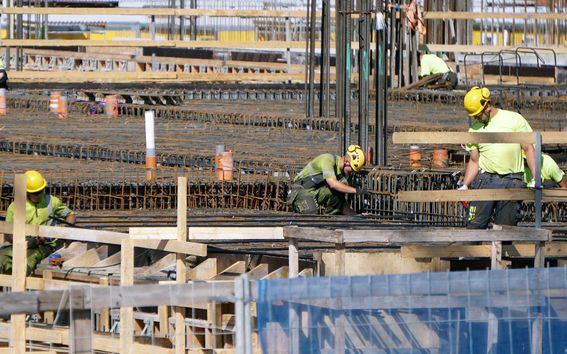How to Digitalise Construction for On-site Workers

What would happen if we could tap into the knowledge of workers on the construction site? Would a real-time situation picture of the site make workers more productive? These are critical questions from Christopher Görsch’s research project, which forms part of Aalto University’s DiCtion program.
The project aims to better understand the work prerequisites and processes as well as the information flow on a construction site for decentralised planning and control. It’s a topic that has been poorly studied so far, even if it has a substantial impact on construction performance.
“It's not the process itself that is getting your job done. It's the people. Somehow, we have to consider them more and more, bring them into the game, and especially their knowledge,” Görsch reminds us.
Görsch’sproject is well in line with his PhD work on collaborative planning and control on site to achieve situational awareness. He started his PhD research in Hannover, but decided to continue it at Aalto University.Earlier in his academic career, he studied economics and construction in Germany and sustainable construction at National Central University, Taiwan and Stanford University, USA.
The Knowledge-based Industry
Construction has a stigma of being conservative and unproductive. On the other hand, construction projects usually deliver the expected product, unlike many projectsin the innovative software industry.
“Construction is a knowledge-based industry that contains a lot of manual work and relies on the skills of people,” says Görsch. “It’s a siloed, fragmented industry. The management model is top-down; information comes from one direction and does not go the other way around.”
There’s plenty of knowledge in the industry, but it resides in human memories. Best practices and tacit knowledge move from one project to another in people’s heads; sometimes they are not transferred at all. To make construction less dependent on individuals’ capabilities and to make it more like systematic production, you need to start planning and managing it differently.
Why Construction Planning Fails
Construction planning is an excellent example of centralised, top-down thinking. Plans and schedules are madewith good intentions, but still, most of them fail. Experience and research have shown that one-week lookahead plans are only about 50 percent accurate, whereasthose tasks planned three months in advance practically never hit the mark.
The reason for failed plans is that they are done without considering the realities of the construction site. They may borrow from schedules in earlier projects, but even those were probably never updated to reflect the actual progress.Downstream actors, trade partners, foremen, and workers on the construction site have typically little influence over schedules.
Scheduling and planning are critical to construction productivity, as is the flow of information between participants and processes. To compensate for the shortcomings of the current practices, project participants add buffers and risk premiums in their original schedules and bids.
On-site monitoring performed withinDiCtion- and other Aalto-led research projects have shown that detailed planning and scheduling can easily shorten the construction time by 50 percent without excessive pressure on workers. For example, in oneparticular takt production project, a 20 percentworker presence at the workface was enough to keep the project on the radically reduced schedule.
How to Better Understand Construction Work and Information Flows
To further develop construction, we must first know the baseline and potential. Görsch’s project looks to scrutinise how information in plans and schedules supports on-site decision making and worker performance. He also aims to explore future opportunities for improving situational awareness on construction sites.
He and his teammates have come up with a survey that they want around 1000 construction workers to undertake. It’s an extensive questionnaire that takes around25 minutes to complete.The 37-question-long survey asks the participants specifically about situational awareness, worker routines, the hardware and software they use, and interaction and knowledge transfer.
The research team has amassed valuable feedback from pilot tests regarding the content and the terminology. They plan to launch the survey during the first quarter of 2020. It will be available in both Finnish and English, as an online and a paper version.
How De-centralised Planning and Situational Awareness Will Change Construction
We already have promising experiences from utilising the Last Planner System within construction planning. This system brings together the people who actually do the construction work and allows them to plan the schedule collaboratively. Combine that with integrated project delivery, IPD, and the walls of the silos will shrink as the participants share the same goals and incentives.
Situational awareness, in turn, will empower teams and individual workers on the site. Instead of waiting for instructions from a foreman, a worker gets his or her instructions from a digital service. The information could be about what to do and where, where the equipment and materials are, and whether there are any safety-related issues in relation to the task. In addition, situational awareness would reveal, in advance, whether there are going to beany potential conflicts between tasks or workspaces, and whether there could be any factors that may potentially disrupt the planned schedule.
To achieve the desired state, workers’ tacit knowledge must be utilisedin planning the projects and digitalising their workflows.
Data is the other necessary ingredient. This will come from various operational and design systems and on-site sensors and cameras.To make data flow in parallel to work, project participants must open their gates and make data available in a format that’s machine-readable. DiCtion has already developed an ontology that describes a generic data model for construction. It forms a sound basis for software development and automated information processes.
Individual Benefits
Görsch believes that situational awareness and digitalisation will not only lead to better productivity but also to an improvedquality of work life through distributed scheduling and decision capabilities.
This can enable crews to a higher grade of self-management by providing a foundation to profound decision making which is supported by real-time data, transparency of project-stakeholders and more trustworthy plans and schedules. Overall,Görsch hopesit leads to an understanding of all individuals as contributors to the final product.
- Published:
- Updated:
Read more news

Aalto ARTS alum Vidha Samya’s artwork featured at the Venice Biennale 2024
The Pavilion of Finland presents ‘The pleasures we choose’ at the 60th International Art Exhibition – La Biennale di Venezia until 24 November 2024.
IoT Forge donates EUR 1 million to the School of Engineering
The donation will be used for research and education on the Industrial Internet and digital twins.
Join us for the first Aalto Open Science Award Ceremony
All Aaltonians are welcome – no registration required!